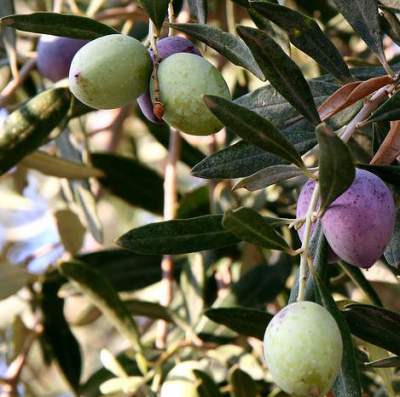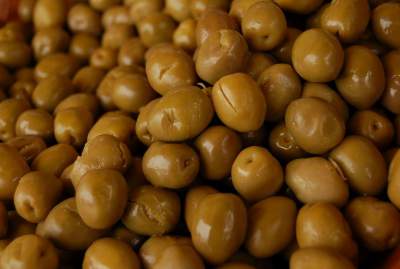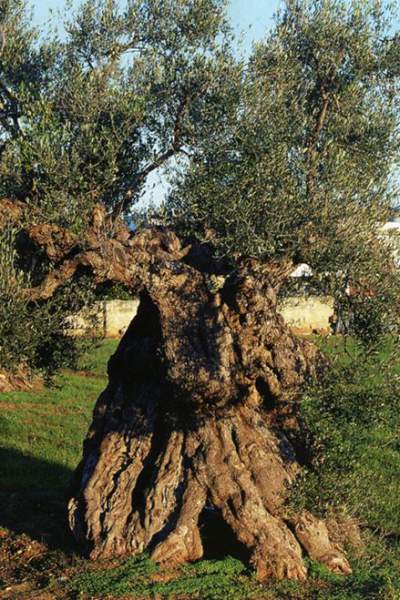Local Olive Curing
Olive Curing Water Curing “Smashed” or “Cracked” Olives Extra reading material about growing Olives over here in Spain
Water Curing “Smashed”or “Cracked” Olives 
Olive Curing (Easy recipe)
(Recommended for large green olives)
Wash olives. With stone or mallet, crack the meat of the olive, taking care not to bruise the pit.
Put the olives in a pan and cover with cold water for 6-8 days, changing the water twice a day, morning and evening, until the bitterness is gone (taste to test).
When ready, fill the pan with brine * (about 1 part sea salt to 10 parts water) and lemon juice (about 1 part lemon juice to 10 parts water), transfer to jars if desired, and refrigerate for several hours before eating. **
Tips about Brine:
** For cracked olives, when they’re ready to eat, transfer to a brine that’s less salty to keep for long periods.
Salt-Cured Ripe Olives.
Moderate recipe
Recommended for large green olives
“This pungent recipe was given to me by an old Spanish man”
Olive Curing Ingredients
5 pounds green mature olives.
1-1/2 quarts water.
3 tablespoons salt.
2 lemons cut into 1/2-inch cubes.
2 tablespoons dried oregano.
Now 2 cups white wine vinegar.
6 cloves garlic, peeled and halved.
2 tablespoons cumin seeds, crushed in a mortar.
Olive Oil.
Olive Curing Preparation.
Crack the flesh of the olives with a rolling pin, or by hitting each one individually with a hammer. Rinse with cold water.
Place them in a stoneware, earthenware, glass, or porcelain jar and cover with cold water.
Weight them with a piece of wood or a plastic bag filled with water (to keep the olives submerged) and keep them in a dark, cool place for ten days, changing the water every day.
Boil the water and dissolve the salt in it. Empty the liquid from the jar in which the olives have been soaking; rinse the olives in cold water and cover the olives with the salt brine.
Mix in the lemons, oregano, vinegar, garlic, and cumin. Float enough olive oil on top to cover the surface. Store in a cool place for at least two weeks. The olives keep quite well for at least two months.
How to Cure the Perfect Olives / Come curare le olive perfette / Cómo curar las aceitunas perfectas
Curing olives in brine.
I hope you enjoy this 10 minute how-to video where I explain the process of preserving olives at home.
First up collect jars! Sliced Olives will take 6-7 weeks to cure with this method, pitted olives 3 weeks. Some people whack them with a hammer but I’ve not tried that method.
You are going to need lots of salt, so buy it in bulk! It’s best to cure olives in a sealable container to minimise air contact, a catering bucket with a lid or a straight sided home brew drum works well.
You will need a plate or bowl that snuggly fits inside your container to sit on top of the olives to keep them submersed.
Green Olives
Greens olives are more bitter and will take longer to cure than ripe (black) olives. It’s OK to mix them together in the same batch but you will need to continue curing until the green olives have lost their bitterness.
When the olives are picked keep them in water until they can be sliced/pitted, discard any with blemishes.
Taste one before they are cured, this will give you some idea how bitter they are!
Slicing:
Each olive needs a slice down one side to allow the brine to work its way in and break down the bitterness.
Cut olives length ways to the pip with a small paring knife.
Place sliced olives into a bucket of water until salt is added.
Pitting: If you have a pitting tool I recommend using it. It takes the same amount of time, the olives cure quicker and you fit more in each jar … win, win. Brining:
Once all sliced olives are in the bucket rinse and drain before re filling with tap water.
You don’t need to be too accurate here, 1½ cups of salt per bucket of olives is good. [Note: the video graphic at 04:33 says “1.5 cups salt per 10 litres”.
This is not per bucket of water but per bucket of olives, enough water is poured in to cover the olives with enough room to submerge them with a plate.
Fill with water and mix through well to dissolve the salt as it sinks to the bottom.
Liquid
Be sure there is enough liquid to cover and submerge the olives with a plate, bowl casserole lid or whatever you can sneak out of the kitchen without “Her In-doors” finding out.
Put the plate on top of olives and submerge. If you have a lid for the bucket put in on … if not seal the top with a bin liner or bag to minimise contact with the air.
In the first week the brine needs to be changed 3 times as a foam will develop on top of the brine during malolactic fermentation.
When draining the brine I recommend rinsing once before refilling and adding the next lot of salt.
After the first week the brine will only need changing once a week … remember to rinse the olives when changing! Pitted olives: at the end of 3 weeks taste, you will know if they are not right. Sliced olives: test after 5 weeks.
Keep going with the process until you are happy the bitterness is gone, this may be 6 or 7 weeks with sliced olives.
As long as you keep changing the brine you can go as long as you like until you are ready to put them in jars.
Jars:
Clean jars thoroughly in hot soapy water and rinse well. When they are ready give your olives one last rinse just before placing into jars.
Mix a weak brine: ⅓ cup salt to 8 cups (2 litres) water … heat this in the microwave on high for 10 minutes.
Line up all the jars and use a strainer to lift the olives out of the drum, then place in jars. Per medium sized jar (300 ml): add ½ teaspoon dried herbs, 1 tablespoons white wine vinegar.
Pour heated brine into jars, top with extra virgin olive oil & seal lid. The warm solution should help seal the lids when it cools & contracts.
Cooking holidays in Spain, for all food lovers
Do you love Spanish cuisine so much that you want to learn how to cook it?
Then, there is no better way to learn than to go on a local cooking holiday in Spain. Select the destination of your choice and let some of the best Spanish chefs out there introduce you to creating some of the most delicious Spanish dishes.
Reserve yourself a spot on one of our many cooking vacations in Spain and become the culinary master you know you can be!
Spanish Cookery Index
Olive Curing
Gardening in Spain
Spain info covers local towns with local accommodation. Site info also covers info local days out in Spain on the Mediterranean. Info with information on gardening in Spain Mediterranean style. Spain info with information on cooking Mediterranean style.
Site also covers Bowls Clubs Golf Go Karting fishing Caves and other sports here in the Mediterranean.
Spain info also lists the Local Hot Water Spas many of them dating back to Roman times.
Spain Info
Olive Curing
Optimised March 21 P93 W100 Aug 25 H 72 Dec 23 Jan 4 Olive Curing 9 H 92 May 7 Olive Curing 12 H 95
SPAIN INFO Olive Curing San Francisco De Asis, Urb Marina, San Fulgencio, 03177, Alicante, Spain. 38n21, 0w29
Site Disclaimer
Disclaimer: Whilst every effort has been made to provide accurate information, no liability will be accepted for misinterpretation, misrepresentation, errors or omissions - the information provided by our Websites is for use as a guide only and is issued in good faith as information..
All photographs images and FILM material is subject to the understanding that as they are in the public domain they can be used and shared as seen to be appropriate and unless showing a sign that they are covered by copyright law. This also covers Social media operations.
1999---2024



